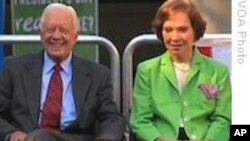He is one of the most active former Presidents of the United States. In addition to authoring more than 25 books, former President Jimmy Carter continues to travel the world in an effort to help spread democracy and improve the health of the world's poor. His efforts since leaving office almost 30 years ago are now at the center of a multi-million-dollar renovation of the Jimmy Carter Library and Museum in Atlanta, Georgia. President Carter described how his life after the White House forms an important part of his legacy.
Former President Jimmy Carter and his Vice President Walter Mondale are the longest living post-presidential team in U.S. history.
"Not only that, we passed up our competitors [Thomas] Jefferson and [John] Adams two years ago! And, I'm not being critical of them, they were good too," he said. "But we're still going!"
Mondale made those remarks at the opening of a newly redesigned Jimmy Carter Library and Museum in Atlanta on the day Mr. Carter celebrated his 85th birthday.
The facility, after its $10 million renovation, now includes work the former President took on later in life, something unprecedented for a presidential library.
"I wanted to show as much as possible since the White House years, so about a third of the total presentation is devoted to the years since I left the White House," he said.
Some of the new exhibits focus on efforts of the Carter Center around the world. Interactive displays show the many places where Mr. and Mrs. Carter have traveled to monitor elections, promote peace and democracy, and eradicate Guinea Worm Disease and other illnesses. That work earned former President Carter and his staff at the Carter Center a Nobel Peace Prize in 2002.
Dr. Paul Emerson leads one of the center's health efforts around the world. He says the new exhibits draw attention to diseases in developing countries that have been overlooked. "Busloads of grade school kids will come through, and they will be exposed to what these conditions are, and the more people are exposed to these things, the more they can empathize and sympathize with people who suffer," he said.
Some exhibits focus on the highs and lows of Mr. Carter's four years in the White House.
Visitors can watch a massive multi-media display of one day in the Carter White House, from the moment the President wakes up until his day ends late at night.
The Iran hostage crisis dominated the final year of Mr. Carter's presidency. An exhibit focuses on that crisis, a time when, according to Mr. Carter, there were two White Houses, one running the country and the other exploring ways to free the hostages.
The museum's re-design gives the former president the chance to open up more of his life to the public, something he hopes to continue with his next book, an abridged version of the 5,000 pages of diary notes he kept while in office.
"It will tell not only about the glory of being President, sometimes the anguish of being President, the pride of being President, my inner most thoughts, how I dealt with my family under those circumstances, the people I liked and didn't like, how my opinion changed as time went on. I think it's going to be an interesting book," he said.
Former President Carter plans to deliver the book to his publisher late next year.






